|
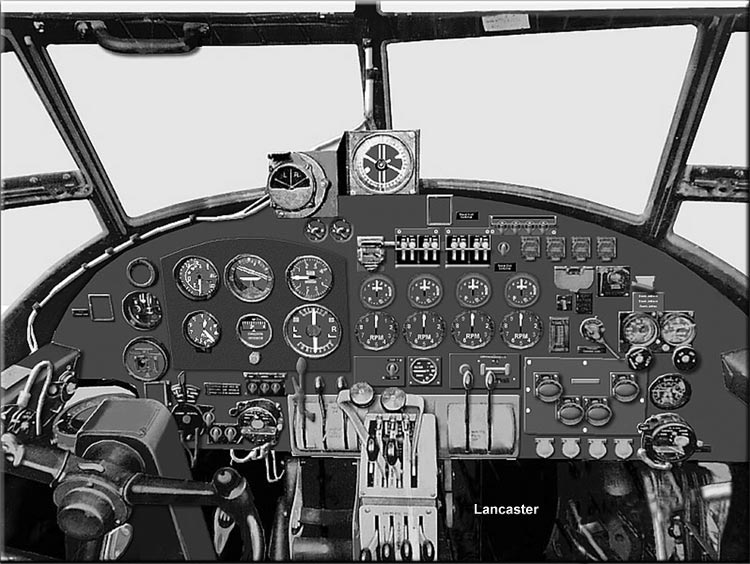
Bomber
Command Lancasters were configured for single pilot operation
|
|
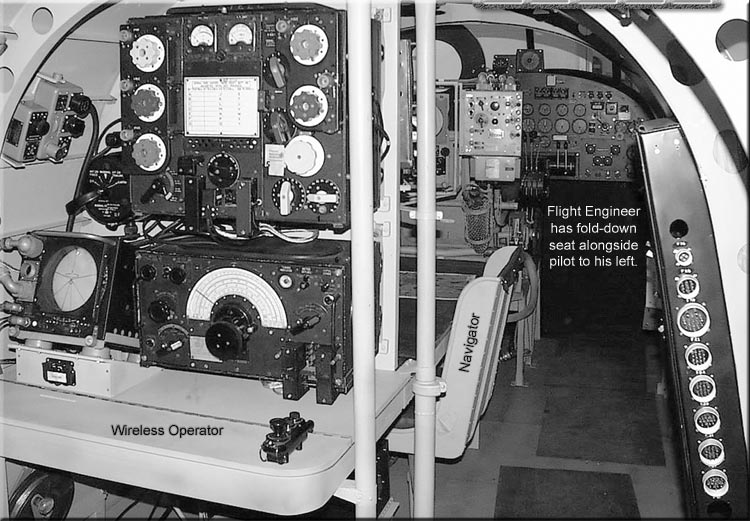
Wireless
Operator at left, Navigator’s Station forward of Wireless Operator
and behind Pilots seat, LHS.
Flight
Engineer’s fold-down seat alongside pilot with additional
instrumentation and controls on side panel. |
|

Portion of Flight
Engineers Side Panel
|
|

Rear Turrett (4 x
0.303 Browning Machine Guns with 10,000 rounds)
|
|
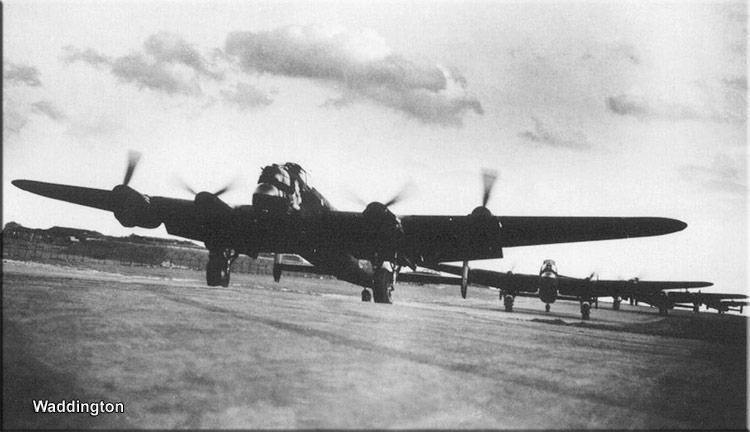
Lancasters lined up
ready for take-off, Waddington, UK 1944
|
|

This is a
reproduction of a picture hanging in the Committee Room of “The
Clermont Club”, Clermont, QLD.
The inset
photograph is that of F/S Brian Bennett, the Rear Gunner who came
from Clermont, Qld.
The
signature is that of Air Vice Marshall R. A. Cochrane, then
commander of 3 Group and
5 Group
Bomber Command, later to become Sir Ralph Cochrane, Air Chief
Marshall.
(“Modane” refers to the Modane Rail Marshalling Yards on the
French-Italian
border
targeted by 467 Squadron & others 10/11/43)
Reference to Pilot Officer Fayle refers to his
rank prior
to his promotion to Flying Officer on
25/1/44 |
|
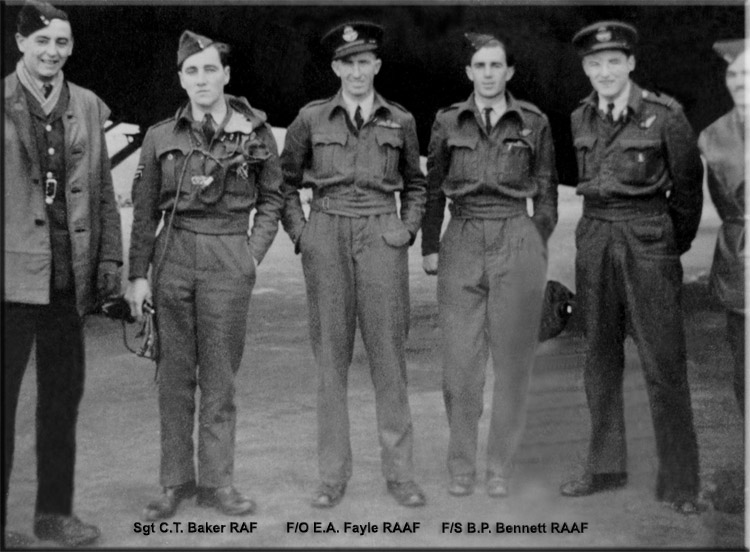
Somewhere
in England 1943 ~ 1944 (1 crew member absent)
Sgt C.T.
Baker 2nd from left, Flight Engineer, F/O Ernie
Fayle, Pilot, 3rd from left - F/S
Brian Bennett, Rear Gunner, 4th from left.
It is
believed that F/O F. Chappell, Navigator, is 5th from left.
Ernie Fayle and Brian Bennett were Australians
(RAAF)
with Christopher Baker, together with the other 4 crew members being from the RAF.
|
|
Ernie's Statement of Service obtained from the
Australian Government, Department of Defence.
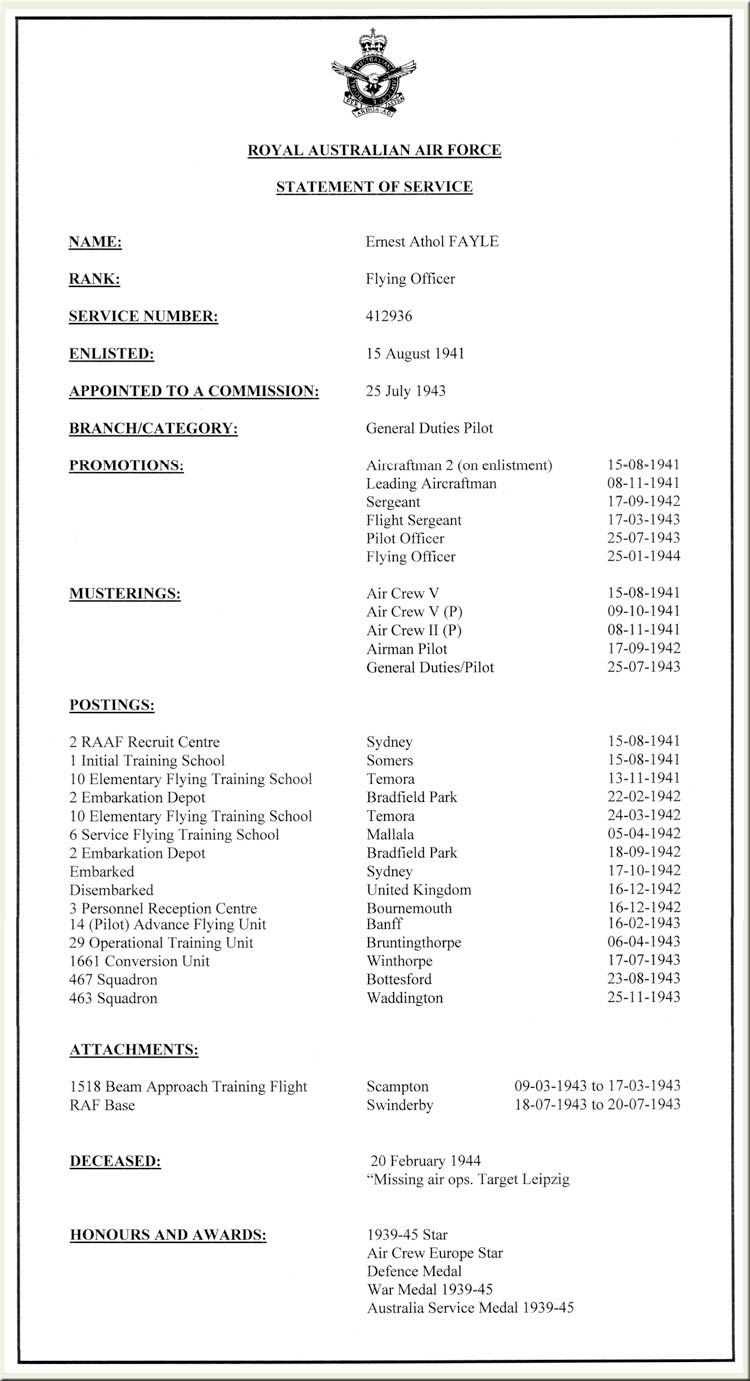
POSTINGS
|
Sydney,
15/8/41 |
Enlisted. |
|
Somers,
15/8/41
(13 weeks) |
Aircrew recruits were initially
sent direct to No.
1 Initial Training School at
Somers in Victoria. |
|
Temora, 13/11/41
(14 weeks) |
Elementary Flying
training (Tiger Moth). |
|
Bradfield Park,
22/2/42
(30 days) |
Initial
Training School. |
|
Temora 24/3/42
(12 Days) |
Elementary Flying
training. |
|
Mallala, SA 5/4/42
(24 weeks) |
Service Flying Training School. Avro Ansons and Oxfords
(twin engined aircraft) used for advanced training. |
|
Bradfield Park, 18/9/42
(29
days) |
Embarkation Depot. |
|
Sydney, 17/10/42
(29
days) |
Embarked. |
|
UK,
16/12/42 |
Disembarked. |
|
Bournemouth, 16/12/42 |
Personnel Reception Centre. |
|
Banff, 16/2/43
(7
weeks) |
Advanced Flying Unit. |
|
Bruntingthorpe 6/4/43
(14 Weeks) |
Operational Training Unit |
|
Winthorpe, 17/7/43
(5
weeks) |
Conversion Unit. |
|
Bottesford 23/8/43
(3
months) |
Posted to 467 Squadron. First Operational Posting. |
|
Waddington, 25/11/43
(12
Weeks) |
Posted to newly formed RAAF 463 Squadron. Final
Posting to newly formed 463 Squadron. |
|
To download a PDF
file of "Statement of Service" and "Postings" Right
Click and "Save Target As"
|
 |
|
|
Bottesford RAF Base
RAF Bottesford is located in Leicestershire, 6 miles
north-west of the town of Grantham.
The airfield became operational in November 1941 with the
arrival of No. 207 Squadron from Waddington.
This squadron, the first to be equipped with the
troublesome Manchester, was relieved to start exchanging
them for Lancasters in March 1942. A new Australian
manned squadron, No. 467, arrived on 23rd
November 1942 commencing operations on the night of
January 2/3, 1943.
In November 1943, No. 467 Squadron was moved out to Waddington
as Bottesford had been allocated to the
USAAF's IX Troop Carrier Command for the forthcoming
operation.
(Ernie and crew were first stationed here with 467 Squadron
23/8/1943 ~ 25/11/1943)

Waddington RAF Base
RAF Waddington is located in Lincolnshire, five miles south of
the city of Lincoln.
The first military flying took place at Waddington with the
arrival of 47 & 48 Reserve Squadrons in
November 1916, when the Station opened as a flying
training unit, a role it continued until the end of the
First World War.
The base was closed in 1919, but was opened again in October
1926. At a later date, Waddington came
under the control of Bomber Command and two squadrons
were re-formed there in 1937.
No. 44 Squadron at Waddington became the first to receive the
new Lancasters, which were taken into
action for the first time on March 10/11,1942 when two
No. 44 Squadron aircraft attacked Esse.
In November 1943 Waddington saw the arrival of the Australian
No. 463 squadron with 30 Lancasters from
Bottesford. The squadron became operational immediately
and it participated in the raid on Berlin on
November 23/24, just a few hours after it was formed.
Altogether, Waddington lost more bombers on
operations than any other Bomber Command station, a
total of 345 of which 227 were Lancasters.
(Ernie and crew transferred from 467
Squadron to the newly formed
463 Squadron and were
relocated to Waddington 25/11/43)

No. 467 Squadron, RAAF
No. 467 Squadron, RAAF was formed at Scampton, UK on
7/11/1942. Although intended as an Australian
squadron the majority of the personnel were initially
British. However, towards the end of the war the
squadron comprised a majority of Australians.
The squadron relocated to Bottesford on 23/11/1942 and
commenced operations on 2 January 1943. The
squadron moved to Waddington on 12/11/1943 which
remained the squadron's home until the end of the
war. Equipped with Avro Lancaster heavy bombers, and
forming part of 5 Group, RAF Bomber Command,
the squadron's operational focus for much of the war
was the strategic bombing offensive against Germany.
Bombing almost entirely by night, it participated in
all of the major campaigns of the offensive. After the
end of WW2 467 Squadron moved to Metherington on
16/6/1945 and was eventually disbanded in October
1945.
(Australian War Memorial, Canberra archives)

No. 463 Squadron, RAAF
No. 463 Squadron, RAAF was formed from C Flight of 467
Squadron RAAF at Waddington, UK on
25/11/1943. Like 467 Squadron, 463 was equipped with Lancaster
heavy bombers and formed part of 5
Group of RAF Bomber Command. The squadron began operations the
night after its formation with an
attack on Berlin. Night raids on Germany became a focus of the
squadron's activities and it was heavily
engaged during the Battles of Berlin and the Ruhr. It
also took part in numerous raids on the sites used to
assemble and launch V1 flying bombs and V2 rockets
against Britain.
No. 463 RAAF Squadron sustained the highest loss rate of any
of the Australian bomber squadrons.
(Australian War Memorial, Canberra archives) |
|
The following is a history of the Lancaster that Ernie commanded
during his last 12 missions. These include
3 sorties carried out in November
1943 whilst still attached to 467 Squadron, (Kassel, Dusseldorf and
Modane) which do not appear as “Key Operations” on the
listing below.
The information below has been extracted from a web site dedicated
to providing as much information as
possible about “Lost Bombers”;
http://www.lostbombers.co.uk/bomber.php?id=423
Legend:
# = “Key Operation”,
* = Commanded by F/O Ernest Athol
Fayle

Lancaster
DV338 Information
Type
Lancaster Mk I
Serial
Number DV338
Squadron
463
X1D
JO-C
Operation
Leipzig
Date 19th
February 1944

Further Information
"Serial Range DV155 - DV407
This aircraft was one of 200 Lancasters
ordered from Metro-Vick in 1941 and built as 91 Mk.1s with Merlin
22 engines and 109 Mk.111s with Merlin 28
engines mixed, from May 43 to Nov 43.
DV338 was a Mk.1 and was delivered to A.V. Roe
10 Oct 43 for 'Quality Control Inspection', and issued to
No.617 Sqdn, then to 619 Sqdn 16 Oct 43 but
immediately transferred to No.467 Sqdn 21 Oct 43, joining
463 Sqdn 25 Nov 43.
Took part in the following Key Operations:
With No.467 Squadron;
Kassel 22/23 Oct 43 *
Dusseldorf 3/4 Nov 43 *
Modane 10/11/Nov 43 *
Berlin 22/23 Nov 43; #
Berlin 23/24 Nov 43; #
With No.463 Sqdn as JO-C;
Berlin 26/27 Nov 43; # (463 Sqdn's first
Bombing Raid)
Berlin 2/3 Dec 43; #
Berlin 16/17 Dec 43; #
Berlin 23/24 Dec 43; #
Berlin 29/30 Dec 43; # *
Berlin 1/2 Jan 44; # *
Brunswick 14/15 Jan 44; # *
Berlin 20/21 Jan 44; *
Berlin 27/28 Jan 44 # *
Berlin 28/29 Jan 44; *
Berlin 30/31Jan 44; # *
Berlin 15/16 Feb 44; # *
Leipzig 19/20 Feb 44, Lost. # *
When lost this aircraft had a total of 186
hours.
Airborne 23:20 19 Feb 1944 from Waddington.
Lost without trace.
All are commemorated on the Runnymede
Memorial.
F/O E.A. Fayle RAAF KIA
Sgt C.T. Baker RAF KIA
F/O C.L. Chappell RAF KIA
Sgt L.K. Topham RAF KIA
Sgt R.J. Farrell RAF KIA
Sgt A.L.N. Vickery RAF KIA
F/S B.P. Bennett RAAF KIA
|
|
![]()
![]()